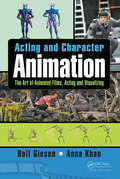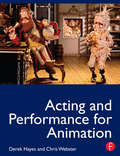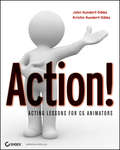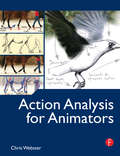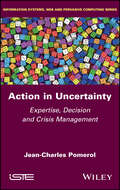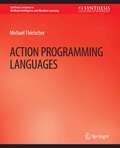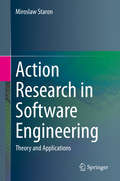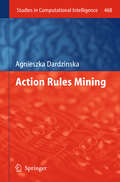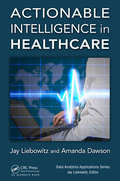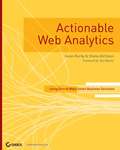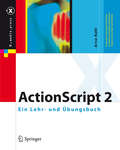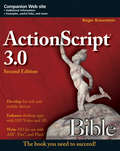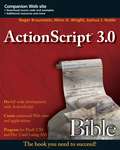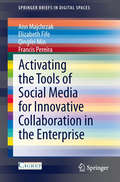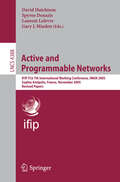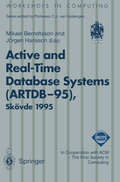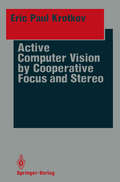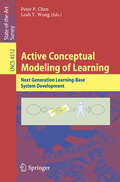- Table View
- List View
Acting and Character Animation: The Art of Animated Films, Acting and Visualizing
by Rolf Giesen Anna KhanAnimation has a lot to do with acting. That is, character animation, not the standardized, mechanical process of animation. Acting and animation are highly creative processes. This book is divided into two parts: From film history we learn about the importance of actors and the variety of acting that goes into animation; then, we will turn to the actor's point of view to describe the various techniques involved. Through exhaustive research and interviews with people ranging from the late Ray Harryhausen, Jim Danforth, Joe Letteri, and Bruno Bozzetto, this book will be the primary source for animators and animation actors. Key Features Interviews with industry legends are found throughout this exhaustive work on animation From film history we learn about the importance of actors and the variety of acting that goes into animation, then turn to the actor's point of view to describe the various techniques involved Coverage of acting from Vaudeville to Rotoscoping to Performance Capture Case studies throughout bring the content to life while providing actionable tools and techniques that can be used immediately
Acting and Character Animation: The Art of Animated Films, Acting and Visualizing
by Rolf Giesen Anna KhanAnimation has a lot to do with acting. That is, character animation, not the standardized, mechanical process of animation. Acting and animation are highly creative processes. This book is divided into two parts: From film history we learn about the importance of actors and the variety of acting that goes into animation; then, we will turn to the actor's point of view to describe the various techniques involved. Through exhaustive research and interviews with people ranging from the late Ray Harryhausen, Jim Danforth, Joe Letteri, and Bruno Bozzetto, this book will be the primary source for animators and animation actors. Key Features Interviews with industry legends are found throughout this exhaustive work on animation From film history we learn about the importance of actors and the variety of acting that goes into animation, then turn to the actor's point of view to describe the various techniques involved Coverage of acting from Vaudeville to Rotoscoping to Performance Capture Case studies throughout bring the content to life while providing actionable tools and techniques that can be used immediately
Acting and Performance for Animation
by Derek HayesCharacter animation involves more than the principles of animation and the mechanics of motion. Unique, believeable characters that think, feel and captivate your audience are ones that involve emotion, performance, personality, acting and story. Successful animators balance all of these elements within a single character and narrative. With Acting and Performance for Animation, discover how to create dynamic, dramatic performances and believeable character interaction. An invaluable resource for animators, Acting and Performance for Animators is a practical guide to the variety of performance techniques relevant to animators. Develop believable character interactions with chapters detailing the principles of performance, performance types, character emotion and personality, physical and psychological performance, and scene composition. Analyze scripts, sound,acting, action and performance with the practical hints and tips, hands-on assignments and animated examples featured in an extensive guide for animators working in film, TV, games and commercials. Explore different performance techniques based upon the experiences of seasoned animators with case studies featuring John Lasseter, Ray Harryhausen, Nick Park, Joanna Quinn. Expand your own performance techniques with the accompanying DVD which will feature live action reference shorts, production stills, animated examples, and further hands-on assignments.
Acting and Performance for Animation
by Derek HayesCharacter animation involves more than the principles of animation and the mechanics of motion. Unique, believeable characters that think, feel and captivate your audience are ones that involve emotion, performance, personality, acting and story. Successful animators balance all of these elements within a single character and narrative. With Acting and Performance for Animation, discover how to create dynamic, dramatic performances and believeable character interaction. An invaluable resource for animators, Acting and Performance for Animators is a practical guide to the variety of performance techniques relevant to animators. Develop believable character interactions with chapters detailing the principles of performance, performance types, character emotion and personality, physical and psychological performance, and scene composition. Analyze scripts, sound,acting, action and performance with the practical hints and tips, hands-on assignments and animated examples featured in an extensive guide for animators working in film, TV, games and commercials. Explore different performance techniques based upon the experiences of seasoned animators with case studies featuring John Lasseter, Ray Harryhausen, Nick Park, Joanna Quinn. Expand your own performance techniques with the accompanying DVD which will feature live action reference shorts, production stills, animated examples, and further hands-on assignments.
Action!: Acting Lessons for CG Animators
by John Kundert-Gibbs Kristin Kundert-GibbsIn order to bring a character to life, it is beneficial for animators to have a solid understanding of acting principles, and this book examines the important skills behind the artistry of creating animated characters. With a particular emphasis on a character’s motions and movement, this unique resource covers the basic elements of acting for CG animation and then progresses to more advanced topics such as internal intent and motivation. Note: CD-ROM/DVD and other supplementary materials are not included as part of eBook file.
Action!: Acting Lessons for CG Animators
by John Kundert-Gibbs Kristin Kundert-GibbsIn order to bring a character to life, it is beneficial for animators to have a solid understanding of acting principles, and this book examines the important skills behind the artistry of creating animated characters. With a particular emphasis on a character’s motions and movement, this unique resource covers the basic elements of acting for CG animation and then progresses to more advanced topics such as internal intent and motivation. Note: CD-ROM/DVD and other supplementary materials are not included as part of eBook file.
Action Analysis for Animators
by Chris WebsterAction Analysis is one of the fundamental princples of animation that underpins all types of animation: 2d, 3d, computer animation, stop motion, etc. This is a fundamental skill that all animators need to create polished, believable animation. An example of Action Analysis would be Shrek's swagger in the film, Shrek. The animators clearly understood (through action analysis) the type of walk achieved by a large and heavy individual (the real) and then applied their observations to the animated character of an ogre (the fantastic). It is action analysis that enabled the animation team to visually translate a real life situation into an ogre's walk, achieving such fantastic results.Key animation skills are demonstrated with in-depth illustrations, photographs and live action footage filmed with high speed cameras. Detailed Case Studies, practical assignments and industry interviews ground action analysis methodology with real life examples. Action Analysis for Animators is a essential guide for students, amateurs and professionals.
Action Analysis for Animators
by Chris WebsterAction Analysis is one of the fundamental princples of animation that underpins all types of animation: 2d, 3d, computer animation, stop motion, etc. This is a fundamental skill that all animators need to create polished, believable animation. An example of Action Analysis would be Shrek's swagger in the film, Shrek. The animators clearly understood (through action analysis) the type of walk achieved by a large and heavy individual (the real) and then applied their observations to the animated character of an ogre (the fantastic). It is action analysis that enabled the animation team to visually translate a real life situation into an ogre's walk, achieving such fantastic results.Key animation skills are demonstrated with in-depth illustrations, photographs and live action footage filmed with high speed cameras. Detailed Case Studies, practical assignments and industry interviews ground action analysis methodology with real life examples. Action Analysis for Animators is a essential guide for students, amateurs and professionals.
Action in Uncertainty: Expertise, Decision and Crisis Management
by Jean-Charles PomerolDespite uncertainty, people are born to act. Faced with environmental aggression and upheaval, inaction is more stressful than action. What choices, strategies or methods need to be implemented so that action is as effective as possible in terms of the objectives to be achieved? We should not delude ourselves about the term "good decision", which does not have much meaning when we act in an uncertain environment and when we know the weakness of forecasts. However, we must know how to act and be capable of taking the most appropriate action. Action in Uncertainty is a real guide to taking effective action when nothing is certain. According to the different types of uncertainty, what are the respective good uses of expertise and intuition? How do we motivate teams and avoid cognitive bias and manipulation? These themes are dealt with in clear and accessible terms to help decision-makers make the right choices in a world that is more uncertain than ever.
Action in Uncertainty: Expertise, Decision and Crisis Management
by Jean-Charles PomerolDespite uncertainty, people are born to act. Faced with environmental aggression and upheaval, inaction is more stressful than action. What choices, strategies or methods need to be implemented so that action is as effective as possible in terms of the objectives to be achieved? We should not delude ourselves about the term "good decision", which does not have much meaning when we act in an uncertain environment and when we know the weakness of forecasts. However, we must know how to act and be capable of taking the most appropriate action. Action in Uncertainty is a real guide to taking effective action when nothing is certain. According to the different types of uncertainty, what are the respective good uses of expertise and intuition? How do we motivate teams and avoid cognitive bias and manipulation? These themes are dealt with in clear and accessible terms to help decision-makers make the right choices in a world that is more uncertain than ever.
Action Programming Languages (Synthesis Lectures on Artificial Intelligence and Machine Learning)
by Michael HexmoorArtificial systems that think and behave intelligently are one of the most exciting and challenging goals of Artificial Intelligence. Action Programming is the art and science of devising high-level control strategies for autonomous systems which employ a mental model of their environment and which reason about their actions as a means to achieve their goals. Applications of this programming paradigm include autonomous software agents, mobile robots with high-level reasoning capabilities, and General Game Playing. These lecture notes give an in-depth introduction to the current state-of-the-art in action programming. The main topics are knowledge representation for actions, procedural action programming, planning, agent logic programs, and reactive, behavior-based agents. The only prerequisite for understanding the material in these lecture notes is some general programming experience and basic knowledge of classical first-order logic. Table of Contents: Introduction / Mathematical Preliminaries / Procedural Action Programs / Action Programs and Planning / Declarative Action Programs / Reactive Action Programs / Suggested Further Reading
Action Research in Software Engineering: Theory and Applications
by Miroslaw StaronThis book addresses action research (AR), one of the main research methodologies used for academia-industry research collaborations. It elaborates on how to find the right research activities and how to distinguish them from non-significant ones. Further, it details how to glean lessons from the research results, no matter whether they are positive or negative. Lastly, it shows how companies can evolve and build talents while expanding their product portfolio.The book’s structure is based on that of AR projects; it sequentially covers and discusses each phase of the project. Each chapter shares new insights into AR and provides the reader with a better understanding of how to apply it. In addition, each chapter includes a number of practical use cases or examples. Taken together, the chapters cover the entire software lifecycle: from problem diagnosis to project (or action) planning and execution, to documenting and disseminating results, including validity assessments for AR studies.The goal of this book is to help everyone interested in industry-academia collaborations to conduct joint research. It is for students of software engineering who need to learn about how to set up an evaluation, how to run a project, and how to document the results. It is for all academics who aren’t afraid to step out of their comfort zone and enter industry. It is for industrial researchers who know that they want to do more than just develop software blindly. And finally, it is for stakeholders who want to learn how to manage industrial research projects and how to set up guidelines for their own role and expectations.
Action Rules Mining (Studies in Computational Intelligence #468)
by Agnieszka DardzinskaWe are surrounded by data, numerical, categorical and otherwise, which must to be analyzed and processed to convert it into information that instructs, answers or aids understanding and decision making. Data analysts in many disciplines such as business, education or medicine, are frequently asked to analyze new data sets which are often composed of numerous tables possessing different properties. They try to find completely new correlations between attributes and show new possibilities for users. Action rules mining discusses some of data mining and knowledge discovery principles and then describe representative concepts, methods and algorithms connected with action. The author introduces the formal definition of action rule, notion of a simple association action rule and a representative action rule, the cost of association action rule, and gives a strategy how to construct simple association action rules of a lowest cost. A new approach for generating action rules from datasets with numerical attributes by incorporating a tree classifier and a pruning step based on meta-actions is also presented. In this book we can find fundamental concepts necessary for designing, using and implementing action rules as well. Detailed algorithms are provided with necessary explanation and illustrative examples.
Actionable Intelligence in Healthcare (Data Analytics Applications)
by Amanda Dawson Jay LiebowitzThis book shows healthcare professionals how to turn data points into meaningful knowledge upon which they can take effective action. Actionable intelligence can take many forms, from informing health policymakers on effective strategies for the population to providing direct and predictive insights on patients to healthcare providers so they can achieve positive outcomes. It can assist those performing clinical research where relevant statistical methods are applied to both identify the efficacy of treatments and improve clinical trial design. It also benefits healthcare data standards groups through which pertinent data governance policies are implemented to ensure quality data are obtained, measured, and evaluated for the benefit of all involved. Although the obvious constant thread among all of these important healthcare use cases of actionable intelligence is the data at hand, such data in and of itself merely represents one element of the full structure of healthcare data analytics. This book examines the structure for turning data into actionable knowledge and discusses: The importance of establishing research questions Data collection policies and data governance Principle-centered data analytics to transform data into information Understanding the "why" of classified causes and effects Narratives and visualizations to inform all interested parties Actionable Intelligence in Healthcare is an important examination of how proper healthcare-related questions should be formulated, how relevant data must be transformed to associated information, and how the processing of information relates to knowledge. It indicates to clinicians and researchers why this relative knowledge is meaningful and how best to apply such newfound understanding for the betterment of all.
Actionable Intelligence in Healthcare (Data Analytics Applications)
by Amanda Dawson Jay LiebowitzThis book shows healthcare professionals how to turn data points into meaningful knowledge upon which they can take effective action. Actionable intelligence can take many forms, from informing health policymakers on effective strategies for the population to providing direct and predictive insights on patients to healthcare providers so they can achieve positive outcomes. It can assist those performing clinical research where relevant statistical methods are applied to both identify the efficacy of treatments and improve clinical trial design. It also benefits healthcare data standards groups through which pertinent data governance policies are implemented to ensure quality data are obtained, measured, and evaluated for the benefit of all involved. Although the obvious constant thread among all of these important healthcare use cases of actionable intelligence is the data at hand, such data in and of itself merely represents one element of the full structure of healthcare data analytics. This book examines the structure for turning data into actionable knowledge and discusses: The importance of establishing research questions Data collection policies and data governance Principle-centered data analytics to transform data into information Understanding the "why" of classified causes and effects Narratives and visualizations to inform all interested parties Actionable Intelligence in Healthcare is an important examination of how proper healthcare-related questions should be formulated, how relevant data must be transformed to associated information, and how the processing of information relates to knowledge. It indicates to clinicians and researchers why this relative knowledge is meaningful and how best to apply such newfound understanding for the betterment of all.
Actionable Web Analytics: Using Data to Make Smart Business Decisions
by Jason Burby Shane AtchisonKnowing everything you can about each click to your Web site can help you make strategic decisions regarding your business. This book is about the why, not just the how, of web analytics and the rules for developing a "culture of analysis" inside your organization. Why you should collect various types of data. Why you need a strategy. Why it must remain flexible. Why your data must generate meaningful action. The authors answer these critical questions—and many more—using their decade of experience in Web analytics.
ActionScript 2: Ein Lehr- und Übungsbuch (X.media.press)
by Arno KohlFlash und ActionScript sind aus der Gestaltung interaktiver Websites nicht mehr wegzudenken. Autor Arno Kohl von der "Macromedia Akademie für Medien", ist Experte auf dem Gebiet. In Teil 1: Programmierkonzepte sowie die Strukturen der Scriptsprache ActionScript (AS) anhand praktischer Übungsbeispiele. In Teil 2: Workshops zur Erstellung einer Website inkl. spezifischer Elemente - komplexe Preloader, gescriptete (Animations-)Effekte, XML generierte dynamische Menüs, modularer Aufbau mit swf, Bildgalerie, Templates, Spiele, Komponenten. Wer Grundkenntnisse in Actionscripting besitzt, kann die Workshops (auf CD-ROM) schrittweise nachvollziehen.
ActionScript 3.0 Bible (Bible #617)
by Roger BraunsteinThe updated edition on all the latest features and capabilities of ActionScript 3.0 and Flash Player 10. ActionScript is a popular programming language used primarily for the development of Web sites and software. This update to the successful previous version introduces you to all the exciting new capabilities of ActionScript 3.0. You'll see how ActionScript 3.0 goes beyond its primary use of scripting Flash animations and is now an object-oriented evolution that runs ten times faster than previous versions and can be used in Adobe's new platforms, including Flex and AIR. Hands-on instruction and step-by-step tutorials enhance your learning process as you discover everything you need to know in order to harness the power of ActionScript 3.0. You'll learn the nitty gritty of building Rich Internet Applications (RIA) and the ins and outs of putting the new features of ActionScript 3.0 to work for you. ActionScript 3.0 goes beyond its original role as a scripting language and has added development features, incredible speed, and the ability to work with Flex and AIR Shows you how to apply advanced graphic effects using Pixel Blender Demonstrates the all-new text and typography capabilities Addresses your new enhanced control over dynamic sound Explains templated types and new vector data structures ActionScript 3.0 Bible offers you a soup-to-nuts guide on all things ActionScript 3.0 so you can get started working with it immediately.
ActionScript 3.0 Bible (Bible #617)
by Roger BraunsteinThe updated edition on all the latest features and capabilities of ActionScript 3.0 and Flash Player 10. ActionScript is a popular programming language used primarily for the development of Web sites and software. This update to the successful previous version introduces you to all the exciting new capabilities of ActionScript 3.0. You'll see how ActionScript 3.0 goes beyond its primary use of scripting Flash animations and is now an object-oriented evolution that runs ten times faster than previous versions and can be used in Adobe's new platforms, including Flex and AIR. Hands-on instruction and step-by-step tutorials enhance your learning process as you discover everything you need to know in order to harness the power of ActionScript 3.0. You'll learn the nitty gritty of building Rich Internet Applications (RIA) and the ins and outs of putting the new features of ActionScript 3.0 to work for you. ActionScript 3.0 goes beyond its original role as a scripting language and has added development features, incredible speed, and the ability to work with Flex and AIR Shows you how to apply advanced graphic effects using Pixel Blender Demonstrates the all-new text and typography capabilities Addresses your new enhanced control over dynamic sound Explains templated types and new vector data structures ActionScript 3.0 Bible offers you a soup-to-nuts guide on all things ActionScript 3.0 so you can get started working with it immediately.
ActionScript 3.0 Bible (Bible #433)
by Roger Braunstein Mims H. Wright Josuha J. NobleThis description refers to the first edition of ActionScript 3.0 Bible. For the greatly revised and updated second edition published in April 2010, search on author Roger Braunstein’s name or for ISBN 0470525231. ActionScript has matured into a full-fledged, object-oriented programming language for creating cutting-edge Web applications, and this comprehensive book is just what you need to succeed. If you want to add interactivity to Flash, build Flex applications, or work with animation — it's all here, and more. Packed with clear instruction, step-by-step tutorials, and advanced techniques, this book is your go-to guide to unlock the power of this amazing language. Learn the basics, apply object-oriented programming, and more.
Activating the Tools of Social Media for Innovative Collaboration in the Enterprise (SpringerBriefs in Digital Spaces)
by Ann Majchrzak Elizabeth Fife Qingfei Min Francis PereiraThe use of social media tools in the enterprise is expanding rapidly and yet, firms are still unclear about the overall value of this activity and how best to facilitate useful outcomes. The focus of this book is, from a managerial standpoint, the control of information, the extent to which such tools can enhance employee satisfaction and how best to use social media tools to attain specific outcomes including innovative collaboration. As companies turn to IT solutions as substitutes for face-to-face engagements, an understanding of the social dynamics – how employees can best communicate, find and use information and generate motivation through computer-mediated activities is fundamental. Lingering questions relate to the strategic use of these tools; many large companies are using Facebook-like applications due to employee demand, but are not studying outcomes comprehensively or managing processes to create desired outcomes. This book fills this knowledge gap through examining the process and results of a controlled study in two companies, one in the US and the other in China. In each company “wiki challenges” were introduced to employees who were provided guidelines to produce goal-oriented outcomes. The book examine the results in each case and suggest guidelines for firms to achieve “wiki-readiness” to support innovation and co-creation.
Active and Programmable Networks: IFIP TC6 7th International Working Conference, IWAN 2005, Sophia Antipolis, France, November 21-23, 2005, Revised Papers (Lecture Notes in Computer Science #4388)
by David Hutchison Spyros Denazis Laurent Lefevre Gary J. MindenThis volume contains the proceedings of the 7th International Working Conference on Active and Programmable Networks (IWAN 2005) that was held during November 21–23, 2005, in Sophia Antipolis, Cote d’ Azur, France, jointly organized by Hitachi Europe and INRIA. IWAN 2005 took place against a backdrop of questions about the viability and - cessity of a conference that deals with an area perceived by many as having run its full course. The Organizing Committee, during the preparations of the conference, took these concerns seriously and reflected them in the theme of this year’s event, entitled “Re-incarnating Active Networking Research,” and expanding the scope of past calls for papers into topics that have emerged from active and programmable networks. The result was a success because we received 72 submissions, a number that - ceeded our expectations and in fact is one of the highest in the history of the conf- ence. The distinguished Technical Program Committee set high standards for the final program; each one of the submitted papers received three peer reviews with detailed comments and suggestions for the authors. In total, 13 papers were accepted for the main program sessions with 9 papers accepted unconditionally and the remaining 4 papers being conditionally accepted with shepherding by selected Program Committee members.
Active and Real-Time Database Systems: Proceedings of the First International Workshop on Active and Real-Time Database Systems, Skövde, Sweden, 9–11 June 1995 (Workshops in Computing)
by Mikael Berndtsson Jörgen HanssonThe areas of active and real-time databases have seen a tremendous growth of interest in the past few years, particularly with regard to their support of time-critical and embedded applications. ARTDB-95 provided, therefore, an important forum for researchers from both communities to discuss research results, and also to chart new directions for the future. As well as the 11 submitted papers presented at the workshop, this volume also contains 4 invited papers on the following topics: the impact of active databases on commercial practice; the optimization of active database transactions; the need for better language, compiler and tool support for real-time databases; and the origin of time constraints associated with data, events and actions. Together the papers give a comprehensive overview of current research, and will provide invaluable reading for academic and industrial researchers and students at both undergraduate and postgraduate level.
Active Computer Vision by Cooperative Focus and Stereo (Springer Series in Perception Engineering)
by Eric P. KrotkovThis book addresses an area of perception engineering which deals with constructive processes. A model of the environment is analyzed using the information acquired from mUltiple viewpoints of multiple disparate sensors at multiple time instants. Although the role of successive model building and active exploration of the environment, as is discussed in this book, is of great importance, only a few researchers of machine perception have thus far addressed the problem in these directions. Krotkov's book, which is a modification and continuation of his highly successful dissertation, focuses on active exploratory sensing in the context of spatial layout perception. He uses stereo and focus to obtain distance By information, and to eventually develop cooperative combining techniques. means of a stereo system with verging cameras, it is demonstrated that the distance measurements can be significantly improved by combining two sources. In addition, the problem of merging information from the multiple views is discussed in detail. As the field of perception engineering seems to be of growing scientific and applied importance, both practitioners and researchers in machine perception will find this book a valuable addition to their libraries. RameshJain Series Editor Acknowledgements I would like to thank Professor Ruzena Bajcsy for her constant encouragement and guidance during the five years of research leading to the dissertation upon which this book is based. Without her help in all matters, this work would never have been possible.
Active Conceptual Modeling of Learning: Next Generation Learning-Base System Development (Lecture Notes in Computer Science #4512)
by Peter P. Chen Leah Y. WongThis volume is a collection of papers presented during the first International ACM-L Workshop, which was held in Tucson, Arizona, during the 25th International Conference on Conceptual Modeling, ER 2006. Included in this state-of-the-art survey are 11 revised full papers, carefully reviewed and selected from the workshop presentations. These are rounded off with four invited lectures and an introductory overview, and represent the current thinking in conceptual modeling research.
